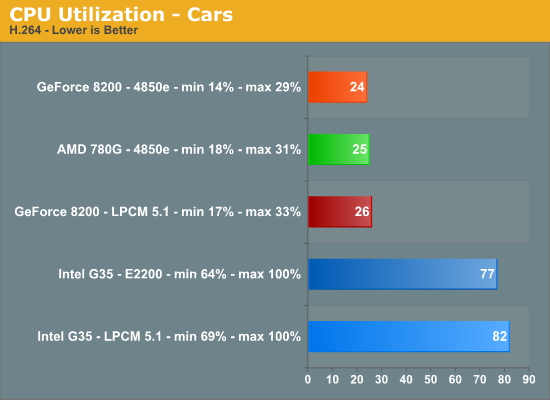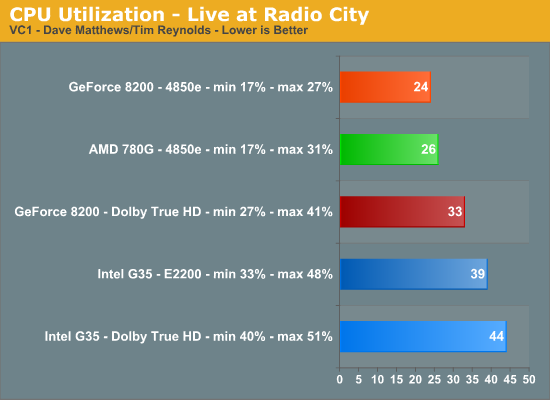AMD 780G: Preview of the Best Current IGP Solution
by Gary Key on March 10, 2008 12:00 PM EST- Posted in
- CPUs
H.264 Video Quality - Cars
One of our favorite movies last year was Cars from Disney / PIXAR. It may be a kid-oriented movie but who can resist fast cars and a love story to boot. This movie offers bitrate levels that average 14.1 Mb/s to 31.9 Mb/s. In our particular test scene, the Hudson Hornet is in the pit lanes acting as crew chief. This image provides an array of colors and contrast opportunities for dissection.
 780G – Click to Enlarge |
 G35 – Click to Enlarge |
 GeForce 8200 – Click to Enlarge |
The differences in the images are small but the GeForce 8200 appears to have slightly deeper colors along with a very slight edge in sharpness that we will discuss shortly. The reference image was in between the G35 and 780G, but even that decision was a tossup in our opinion. However, our test audience voted differently than the reference image with 4 votes in favor of the GeForce 8200, 3 for the G35, and 1 for the 780G.
This is one title that benefits from NVIDIA's new HD Dynamic Contrast and Color enhancements that will vary contrast ratios on the fly while enforcing a slightly stronger color palette across the image. We find this technology is well suited to animated titles but our opinions differ strongly when it comes to natural images. Almost all of us did not like the contrast enhancement technology but several thought the color enhancement feature offered a better overall picture in most cases.

Even though the G35 platform had an excellent image, there is no comparison in the CPU utilization rates during playback compared to the hardware accelerated decoding offered by NVIDIA and AMD. As expected, the 780G kills the G35 with average utilization rates at 25% compared to 77%. Of course, the G35 does not offer hardware acceleration for decoding H.264 (AVC) content and as such suffers from severe judder at times once the CPU utilizations rates go above 95.
In early Phenom testing with the 8.3 release drivers we noticed CPU utilization rates dropping several percent while image quality improved due to the post-processing capabilities on the HD 3200 when paired with an HT 3.0 capable CPU. We will have those results shortly.
VC1 Video Quality - Dave Matthews and Tim Reynolds
We are constantly playing our “Live at Radio City” Blu-ray disc featuring Dave Matthews and Time Reynolds from ATO/RCA/BMG record labels in the labs. It is one of our reference discs for audio quality and besides we just enjoy the music. This disc offers bitrate levels that averaged 13.06 Mb/s to 31.3 Mb/s. In our particular test scene, we see Dave and Tim performing from the right side of the stage. This image provides an array of colors, shadows, and various lighting angles for review.
 780G – Click to Enlarge |
 G35 – Click to Enlarge |
 GeForce 8200 – Click to Enlarge |
The differences in the images are minor but the 780G appears to offer slightly better detail and background image in our estimation. This time, the GeForce 8200 image was faithful to the reference image during playback tests. . Our test audience voted 3 in favor of the GeForce 8200, 3 for the 780G, and 2 for the G35.
This was one test where the opinions differed greatly after watching several minutes of the video. The majority thought the GeForce 8200 offered more “pleasant” tones and brightness control while several thought the 780G provided greater image depth and balanced colors (especially close-ups) that the G35/GeForce 8200 could not.

The 780G and GeForce 8200 offer CPU utilization rates several percent lower in this title than the G35. When using PowerDVD to decode the Dolby TrueHD 5.1 audio stream, we noticed our average processor utilization rate increased about 5%~9% on average.










49 Comments
View All Comments
Gary Key - Tuesday, March 11, 2008 - link
The 790GX features the HD 3300, which is a slight upgrade to the HD 3200 on the 780G. We are told the IGP performance differences will be slightly improved, but until we have the chipset and drivers, it will be difficult to determine if those improvement are meaningful or not. At this time, AMD is quiet about actual specs and capabilities of the 790GX. If you are a very casual gamer, Sims2/UT2004/CoH type of games then Hybrid CrossFire is a decent solution up to 1280x1024 resolution. If you want to run upcoming games and Crysis at an acceptable rate, then discreet graphics is the way to go.At this time, if you want an uATX form factor, the 780G is the best AMD chipset for discrete graphics performance. I have not found any real difference in performance between it and a 770X board with a HD 3870 installed. You need to go up to the 790FX for the best performing chipset with an AM2+ CPU right now. I will update this if we get a performance oriented BIOS for the GeForce 8200 board which may or may not changes its performance capabilities.
Genx87 - Monday, March 10, 2008 - link
Maybe it is late.What is the expected cost and release date of this motherboard?
Gary Key - Tuesday, March 11, 2008 - link
The reader who responded basically answered the supply and price question. :) NewEgg was running a special on the ECS board this week for %59.99 with a rebate. Our information is that all of the launch partners for this board should have supply in the channel by the end of March or early April at worst. The feature sets will determine the prices but AMD was shooting for an average street price of $75 on the 780G. The 780V will be a white box or OEM only SKU for now.The J&W board will not be available in the US or Canada at this time. It is the only board we have in-house that offers the SidePort memory option and with the latest 8.3 drivers, it makes a 5%~10% difference in a few games. AMD is telling us the final 8.4 drivers should allow this option to assist in lowering CPU utilization by a few percent also.
goinginstyle - Tuesday, March 11, 2008 - link
The Gigabyte, ASUS, and ECS boards are available (if in stock) in the Americas at prices ranging from $69 to $99. In Europe and APAC, the J&W boards (along with the others) are available currently. The J&W will be our choice for the more performance oriented user. We expect to see boards from Biostar, abit, MSI, and Foxconn shortly at prices under $100, average MSRP for this chipset should be around $80 once supply is plentiful.goinginstyle - Tuesday, March 11, 2008 - link
Hit the enter button too soon but that information is from another website that will not be mentioned just in case it is a violation of the rules here. I bought the Gigabyte board from NEWEGG last week for $95 and found out today that the 780G chipset shows ENG0752 on it. Any comments on your boards having ENG chipsets?eches - Monday, March 10, 2008 - link
BUT sadly almost useless to me since all my HTPC builds run Linux. It would be VERY interesting to see a comparison in terms of Linux to Windows playback quality/performance since the drivers are bound to make a huge difference here.Also some interesting comments - my Linux HTPC runs an XP2600 (OC to 2.1 Ghz) and only just manages to handle 720p MKV playback. Can a Sempron at 1.8Ghz really manage 720p under Windows? Might be time for an upgrade *grin*
phusg - Tuesday, March 11, 2008 - link
Your hardware should be plenty to playback 720p video. If only something as efficient as CoreCodec's CoreAVC was available for linux. What do you presently use to playback? Is the playback totally smooth?It's also a shame the hardware acceleration of HD video on the newer AGP cards isn't available on the linux side, that would be another cheap way to stretch your hardware :)
eches - Wednesday, March 12, 2008 - link
Smooth at 2.13Ghz, but with some sound sync issues - this is with Xine and all de-interlacing/post-processing disabled (and minimal background processing). And indeed I am awaiting the CoreAVC player for Linux (yes, I could patch MPlayer but I'm also trying to keep the HTPC low maintenance) since this is a quick and cheap way of making the most of this old hardware.And cheers Gary! I look forward to the Linux article with GREAT interest - will you also be taking a look at NVidia cards and doing a quality comparison?
Gary Key - Tuesday, March 11, 2008 - link
We just shipped a 780G board to one of our upcoming Linux editors to test. We should have some initial results in the next couple of weeks. I have not had a pleasurable experience with the Sempron 3400+ doing encoding/decoding work on this board under Vista. It is something I am still working on for a future HTPC article, one that we will recommend/show just how low you can go with the new IGP boards and still have a "well performing" system. Does a Sempron 3400+ and a HD 3450 card for a total outlay of $85 offer better performance on this board than a 4850e CPU only for the same price. This is something we are trying to answer with Intel, NVIDIA, and AMD hardware.eches - Wednesday, March 12, 2008 - link
Sorry I had tacked on a "cheers" at the end of the reply further down - GREAT stuff!"How Low Can You Go?" eh? Sounds very interesting but complex if done properly (i.e. Tests on Vista, XP and Linux; and a need to cover quite a few players in order to do quality/performance comparisons). A look at power consumption would also add an interesting slant - *possibly* putting XP/Vista in a different light when once considers TCO and Linuxs often poor power management.
Personally I was surprised to get a XP2600 to play 720p content and could probably get it smooth without an OC if I used CoreAVC and a dedicated sound card. Given we're talking 6 year old 'junk' hardware here, a free OS etc. thats pretty low!